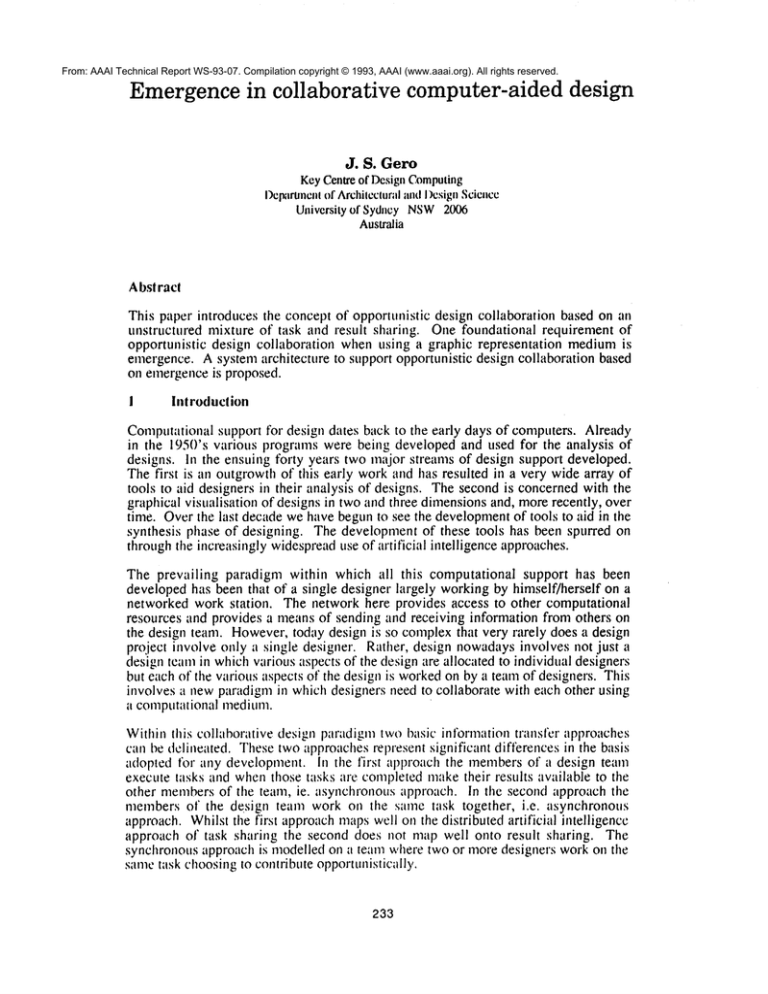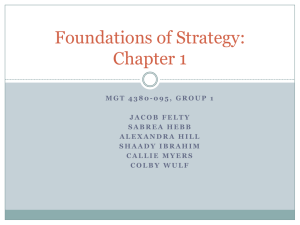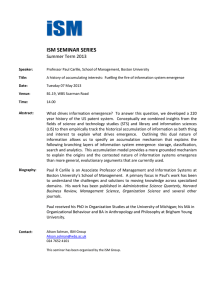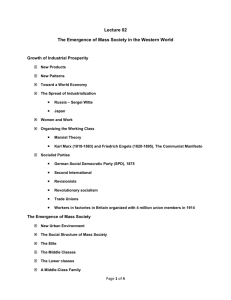From: AAAI Technical Report S-9 -0 . Compilation copyright © 199
advertisement

From: AAAI Technical Report WS-93-07. Compilation copyright © 1993, AAAI (www.aaai.org). All rights reserved. Emergencein collaborative computer-aided design J. S. Gero KeyCentreof DesignComputing I)cl~lruncn! of Archilectural alld DesignScience University of SydneyNSW 2006 Australia Abslrac! This paper introduces the concept of opportunistic design collaboration based on an unstructured mixture of task and resuh sharing. One foundational requirement of opportunistic design collaboration when using a graphic representation mediumis emergence. A system architecture to support opportunistic design collaboration based on emergence is proposed. I Introduction Computational support for design dates back to the early days of computers. Already in the 1950’s various programs were being developed and used for the analysis of designs. In the ensuing forty years two major streams of design support developed. The first is an outgrowth of this early work and has resulted in a very wide array of tools to aid designers in their analysis of designs. The second is concerned with the graphical visualisation of designs in two and three dimensions and, more recently, over time. Over the last decade we have begun to see the developmentof tools to aid in the synthesis phase of designing. The development of these tools has been spurred on through the increasingly widespreaduse of artificial intelligence approaches. The prevailing paradigm within which all this computational support has been developed has been that of a single designer largely working by himself/herself on a networked work station. The network here provides access to other computational resources and provides a means of sending and receiving information from others on the design team. However, today design is so complex that very rarely does a design project involve only a single designer. Rather, design nowadaysinvolves not just a design team in whichvarious aspects of the design are allocated to individual designers but each of the various aspects of the design is workedon by a team of designers. This involves a new paradigm in which designers need to collaborate with each other using a computational medium. Within this collaborative design paradigm two basic inlbrmation transfer approaches can be delineated. These two approaches represent significant differences in the basis adopted for any development. In the first approach the members of a design team execute tasks and whenthose tasks are completed maketheir results available to the other membersof tire team, ie. asynchronous approach. In the second approach the rnembers of the design team work on the same task together, i.e. asynchronous approach. Whilst the first approach mapswell on the distributed artificial intelligence approach of task sharing the second does not map well onto result sharing. The synchronous approach is modelled on a team where two or more designers work on the same task choosing to contribute opportunistically. 233 2 ()pporlunislic Design Collaboralion Opportunistic design collaboration involves a mixture of task and result sharing. However,one of its distinguishing feature is not that, rather it is concerned with allowing more than one interpretation of a particular representation of a design description. In this paper wewill restrict ourselves to a consideration of only graphical representations of design descriptions. The concept of different interpretations of a particular representation is called emergence. Emergenceoccurs whena property that was not explicitly represented or intended in a design description is found zmd made explicit. There are three views of emergence: computational emergence; thermodynamic emergence; and emergence relative to a model (Cariani 1992). Computational emergence is the view that novel behaviours can emerge as a result of local computational interactions (Forrest 1991; Langton 1989). This is one of the approaches to artificial life. Thermodynamic emergence is the view that thermodynamic theory may be used to describe how new, stable bchaviours and structures nay arise at loci removedfi’om knownequilibrium. Emergencerelative to a model sees emergenceas a deviation of the structure or behaviour of a system from an observer’s model of it. It is this latter model of emergence which we wish to use as one basis of opportunistic design collaboration. Figure I shows an example of visual emergence. Designer A uses the single visual form shown in Figure l(a) and locates seven copies of it as shown in Figure l(b). Designer B, however, does not see seven copies of the original form, rather designer B sees two overlapping squares created by those seven copies. In an opportunistic collaborative design environment designer A and designer B are sharing the same electronic whiteboard and design B now wants both of them to work with the overlapping squares for a while. Howcan this be achieved. Figure 1. (a) Simple visual form; (b) seven copies of the single form in particular locations such that a numberof visual forms emerge. 3 Emergence in Collaboralive Computer-Aided Design Emergenceplays an important role in designing and particularly in collaborative design but is not yet supported in collaborative computer-aided design. Emergenceallows for new views of existing situations to be introduced and thus becomes a way of changing the direction or focus of a design. Moreformally, emergence allows for new instances of the schema under consideration which were not previously represented to be found. For example, consider Figure 2. the two triangles labelled TI and T2 have been drawn, triangle labelled T3 is a third 234 triangle which was not drawn but emerges. It is a new instance of the triangle schema and can nowbe used in the continuation of the design. Figure 2. The two triangles TI and T2 are drawn whilst the triangle T3 emerges as a newinstance of a triangle. Emergence also allows for new schemas to emerge, schemas which were not in the original representations. For example, consider Figure 3 which shows a form produced and represented as a sixteen-sided form from a schemaof a sixteen-sided form. Figure 4 shows two squares which emerge from the form in Figure 3. These squares are based on a new schemadiscovered using a data-driven or feature-driven search process (Gero and Yan 1993). Figure 3. A sixteen-sided form produced using a schemaof a sixteen-sided form. 235 t--I I I I I I " .... ...... I I I I I I I I I I I I Figure 4. 4 Two four-sided fornls which emerge from the sixteen-sided form shown in Figure 3, bt, t which have a different schema to the original form. Architectures for Opportunistic Design Collaboration Computer support for synchronous collaborative design is now being researched (Maher anci Saad 1992) and various architectures for multi-user synchronous CAD systems are being developed. Figure 5 shows one such architecture. Session Server / / aL1 ~oordinator -’ I ~ Visual I k,~ Interface I t_ ~ / ~.. I~-- ~ Applicatk,n ~ -- -- ~, -~oorclinator 2) I ) Shared Visual Representation ( Interface ,~ j’ I I J -- ~" Infimmttion flow Control flow Figure 5. An architecture 1992) for a multi-user 236 synchronou s CADsystem (Maher ,’rod Saad In this architecture two concepts are introduced: a shared tmderlying representation and a shared visual representation. Figure 6 shows an implementedversion of the above architecture where the dxf file provides the shared underlying representation and AutoCAD is the CADsystem. The underlyingrepresentation in this implementationis only accessible througha process in the CADsystem. 1 ~_oordinator 1~ ~(Coordinator ,-4 -;-, ; I 2~ ,~lllll’ed ViSIllll ]lllel’l~lce ~ ~_,I Figure 6. An irnplemented version of the generic architecture (Maher et al 1993). shown in Figure 5 In order for opportunistic collaboration based on emergence to be supported two modifications need to be madeto these architectures. The first is to allow the designers to see the visual aspects of possible ernergent forms, This requires that emergence processes be available at tile shared visual representation level. The second, and more fundamental, is to allow for altern,’tte representations at tile shared underlying representation level. These alternate representations need to modify the dxf file in Figure 6. Figure 7 showssuch an :lrchitecture. Elllt~rgeliCt , J)roct~ss Gero and Y;m (1992) have proposed a process model of shape emergence based on the concept of ’shape hiding’. Shape hiding makes shapes which were explicitly represented become implicit. Thus, the shapes which go to maketip the original or primary form lose their coherence and what is left is only backgroundor unstructured shapes. It is to that background or unstructured representation that emergence processes are applied. Figure 8 shows ;, process model for sh;,pc emergence. 237 ¯ ’" b j I Figure 7. An architecture which allows for opporttmistic design collaboration based on emergence (Maher ct al 1993)¯ shape hiding shape emergence I Figure 8. A process model of shape emergence (Gero and Yah 1992) 238 This modelof emergencerelies on the use of an ahernate representation. A numberof such representations have been proposed. The one based on the concept of ’infinite rnaximal lines’ (Gero and Yah 1992) has been developed and implementedin a single user environment. 6 Discussion A number of al~proaches can be considered in developing collaborative computer-aided design systems. The approach adopted here is to provide support for a model based on two characteristics of collaborative design opportunism and emergence. Opportunistic collaboration demands synchronous computational support. This requires that drawing surfaces be shared rather than one be the progenitor of the others or that one be the original drawing surface with the others copies. Emergencerequires ahernate representations of drawings which allow for the possibility of shape hiding. Both shared drawings surfaces with a shared underlying representation and emergence systems have been developed. This paper proposes bringing them together to provide a different kind of computational support for collaborative design. References Cariani, P. (1992). Emergenceand artificial life, in Langton, C., Taylor, C., Fan-her, J. D. and Rasmussen, S. (eds), Art~ft’cial Life II, Addison-Wesley, Reading, Massachusetts, pp.775-797. Forrest, S. (ed.) (1991). Emergent Computation, Elsevier, NewYork. Gero, J. S. and Yah, M. (1992). Shape emergence by symbolic reasoning Working Paper, Design Computing Unit, University of Sydney, Sydney. Gero, J.S. and Yan, M. (1993). Discovering emergent shapes using a data-driven symbolic model, in U. Flcmming an(I S. Van Wyck (eds), CAADFutures ’93, t’lscvicr, Amsterdam (It> appear). t,angton, G. L. (1989). Art([icial L([’e, Addison-Wesley,Reading. Maher, M. L., Gero, J. S. and Saad, M. (1993). Synchronous support and emergence collaborative CAAD,in U. Flemming and S. Van Wyck(eds), CAADFutures ’93, Elsevier, Amsterdam(to appear). Maher, M. L. ,’rod Saad, M. (1992). Computersupport for synchronous collaborative design, Conference on the Impact of Computers on Design, Key Centre of Design Quality, University of Sydney, Sydney, pp.61-76. 239 240


